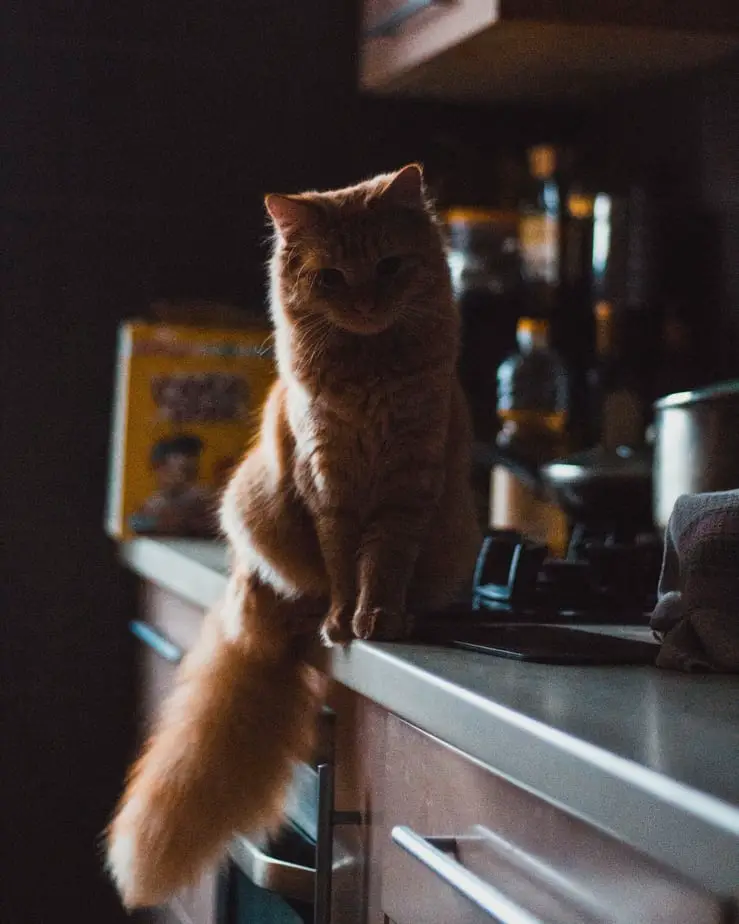More Meows is an Amazon Associate. As an Amazon Associate we earn from qualifying purchases. We may also earn commissions if you purchase products from other retailers after clicking on a link from our site.
Do you own a pet? If you do, then you may have noticed your kitty trying to seat itself on every piece of furniture in the house. Some cat owners may be just fine with this. Many cat owners will not like the idea of cats on their furniture. Whether cats should be allowed on furniture is an important question for cat owners.
Yes, cats should be allowed on furniture if: (1) you do not mind your cat on your furniture and (2) your cat does not scratch your furniture. Do your best to keep your cat off your furniture if you are worried about scratches, cat shedding, or small items getting pushed off.
Cats want to get on furniture for comfort, as an exercise for their limbs, for exploration, or for scratching the object in question. Either way, if you aren’t one of the people that are fine with cats on furniture and you instead want to avoid this nuisance, you may want to deal with this matter tactfully. After all, you must take their well-being into account to build a lasting bond of love between you and your cat.
We explore this practical and interesting subject more in this article. Read on!
Cats and Furniture?

Cats are tree climbers and are generally high jumpers in the open. Their muscled-backs, strong legs, sharp claws for gripping, and highly flexible bodies make them an adept tree-climber. Since, there are no trees for them to climb on at your house (unless you have a cat condo or cat tree), they prefer to climb on furniture- bookshelves, tables, countertops, beds, etc. – you name it; your cat’s go everywhere.
Cats are explorers. They like to know and find out about the environment they are living in – this is why they like getting on top of everything in their line of vision. Getting on top of furniture also gives them a vantage point – they like to survey the area in the vicinity. They may be running from threats – sometimes, other pets – or they may also be looking for possible treats. You can see a lot more from a higher vantage point.
Cats are graceful climbers, though; they will rarely break that Chinese vase or topple your belongings while jumping off places, however, they will sometimes take joy in pushing off small objects. So, you still might want to keep your kitty off your shelves and furniture.
Cats are also great sleepers. Chances are, they are just looking for a warm patch to snooze, undisturbed, and selected the top of your refrigerator for the purpose. Seeking attention is also innate cat behavior.
More often than not, cats would like the attention of their owners – craving a quick snuggle, stroke, or caress could be the reason why they’ve climbed on to your desk to be as near to you as physically possible. This happens to me a lot while working. My Domestic Shorthair cat, Charlotte, will often jump up on my desk and lay down right in front of my keyboard. She likes attention.
Benefits of Letting Your Cat on Furniture
Despite your woes if your feline friend ruins your favorite piece of furniture or your expensive new couch, you may still like the idea of your cat spending time with you (or even without you) on your sofa or other furniture. Here are some reasons why cats want to be on furniture:
To Relieve Stress
Getting on furniture can be a great stress relief for your pet cat. The furniture may allow her to stay out of the path of a dog, provide her security just by being harder for any other creature to access, or just comfort her because it is her preference.
To Keep Muscles and Joints Healthy
Unfortunately, while the furniture scratching could be a drawback to humans, it can be a benefit to cats since it helps keep their claws toned and healthy. In this situation, where your cat is scratching your furniture, my unsolicited advice is to get her some scratching posts.
I have a couple cat trees now with scratching posts on them, and I sprayed them with catnip spray so that my cat understands that is where she should scratch. It worked, she is much easier on the sofa and scratches the scratching posts all the time instead.
To Find Comfort
Some places are warm by default – the shelves on your room, a desk, a window sill, etc. These can provide the perfect place for your kitty to nap and rest. It shouldn’t bother you as cats sleep a lot – I know it seems like my cat sleeps minimum half the day. And a well-rested kitty makes a happy kitty.
To Mark Territory
Cats release scent particles from their paws onto every surface they sit on and eventually scratch. This is a way of marking territory.
To Be Playful
Cats love to be playful and cheeky. If deterred from exploring new things, they may feel glum and this, in turn, would make you unhappy. When you yell at or immediately react upon seeing your cat getting comfortable on your couch or some other furniture, the kitty may interpret this as party behavior or a playful act – they may even be doing it to trigger you and infuse some fun in their lives and get some attention.
Drawbacks of Letting Your Cat on Furniture
Here’s why you shouldn’t let your pet cat spend too much time on your furniture.
Hair/ Fur
Cats leave hair or fur everywhere they go. If you don’t want your bed, couch, or sofa lined with cat fur, train your cat to stop sitting on it. Not only is this unhealthy, but it may also prompt sneezing or allergic reactions. Some cats do shed way less than others, but all cats shed at least a little bit.
Smother Babies and Toddlers
I put this one on the list because I have heard it come up before. Some people believe that cats will smother babies and toddlers. Despite there being no evidence for this, some people still believe it, which is why I wanted to address it. There is truly little risk that this could happen.
Scratches and Tears
Cats do not just sit on carpets and couches, but sometimes they also tear them, nibble on them, and scratch them. And household items, be it furniture or upholstery, are expensive to replace every time your cat has damaged them.
Remember that your cat has hunting skills that she was born with and using her claws is part of that. So, you should find other ways for your cat to exercise this behavior, such as using a scratching post.
There are some furniture materials that cats may not have as much success with scratching, such as microfibers or denim. However, some extremely popular materials such as leather and faux leather can be scratched by cats. We examined this further in our article if cats will scratch faux leather.
Fleas, Ticks, Bugs
Cats may be host to fleas, ticks, small bugs, lice, etc. Allowing them on furniture may mean that these parasites can stick to furniture surfaces and can be rubbed off on to your skin or hair, and then in turn you may have the chance to host them or transport them some more.
How Can You Keep Cats Off Furniture?
There are products that help with keeping cats off furniture.
Scents
There are many commercial herbal sprays available – these don’t harm your cat as they are usually made of essential oils or natural ingredients. Try using it on a small area first to make sure that it doesn’t damage or discolor the furniture.
The scents are generally detested by cats and they can replace their own scent marks. Filling up a spray bottle with apple cider vinegar diluted with water will also deter the cat from your furniture – they hate the smell.
Cat furniture
It may be time to get your cat its own furniture to stop it from messing with yours. Cat scratch posts are easily available. I have had good success with cat trees that contain scratching posts on them. My cat, Charlotte, just knows that these are for her. One thing I did do to ensure she knew that the cat furniture was for her was to spray them (including the scratch post part) with catnip spray.
Mats / Aluminum Foil
Cats sometimes hate plastic mats or rubber mats. Cover furniture tops with these when you’re not using them. Patterned or ridged mats also deter cats as it doesn’t feel comfortable for their paws. The same strategy is also sometimes effective with aluminum foil.

Should Cats Be Allowed on Kitchen Counters?
Health Risks
Allowing your cat on kitchen counters is a terrible idea- cat fur can be a nesting ground for fleas, ticks, and other parasites. Additionally, you don’t want any traces of kitty litter getting around your food since it could carry the parasite Toxoplasma.
Moreover, cats go everywhere – garden, bathrooms, etc. Their paws may be lined with dirt, germs, microbes, urine, feces, and you will not suspect a thing. Anything on their paws will land on the countertop.
If you are unsure if your cat is going on your kitchen counters, you may want to try and put a couple things near the edge or maybe a treat deep in the countertop that your cat won’t be able to see or smell. If the small items (I’ve used balled up paper or some cardboard) are pushed off the ledge, you know your cat has been on the counter.
If the treat is eaten, you know your cat has been on the counter. If they are still there in the morning, my guess is the cat wasn’t on the counter since these things would likely be irresistible to her if she were on the counter.
How to Keep Cats Off Kitchen Counters:
Citrus Cleaners
Lemon, orange, and other citrus fruits are an excellent component of cat repellents for their natural scent, freshness, and their ability to deter cats.
Double-Sided Tape
Place double-sided tapes on your furniture. They are sticky for cat furs, and cats hate it! Try to avoid the use of such tapes on leather to prevent residual marks.
Keep Counters Clean
Keeping your kitchen counter free of tasty snacks will prevent your cat from visiting it frequently. To do this, clean up or remove any leftover food or store it out of sight of your cat. Feed your cat regularly and frequently, without overfeeding it. Keep food and snacks accessible and free for them. Any food that gives off an attractive scent should best be covered to avoid unnecessary attention from your cat.
Aluminum Foil
Line your countertop or unused or rare furniture with aluminum foil. The smooth, anti-slippery surface will prevent the cat from getting on it.
Training
There’s no better alternative than to train your cat to distance itself from your precious furniture – the training will last forever. As soon as you spot your cat on the furniture, gently remove, nudge or redirect her somewhere else. Don’t scream or yell.
You may want to tell her no while you do these things, although my experience with the word no is that my cat does not care very much.
You can use an alert system – a bell, a clicker, or noises from your mouth. They will associate this with something they aren’t allowed to do. Use the same body language, simple words, or a stick to redirect her consistently. Reward positive behaviors as well with a treat.
If you must, assign particularly old or frayed furniture for the use for your kitty. Pet her there to make her used to it. On more expensive furniture, place plastic mats or materials whose textures don’t go well with your cats. When you remove your cat from your nicer furniture, you may want to place her on the frayed furniture that you are calling hers.
Free your sofa of blankets and comfortable pillows; those would be sleeping grounds for your cat. Shift or move furniture sometimes when you see the cat getting comfortable on any particular item.
Lastly, for humanity’s sake, don’t declaw your feline friend – how would you feel if your nails are removed? That is inhuman and shouldn’t be an option!
Summary
If you are comfortable with your cat on furniture then I would tell you to just do your thing – although, you should keep some of the drawbacks in mind, such as some of the parasites. Just be mindful of this.
If you don’t want your cat on your furniture due to one or some of the drawbacks listed above, I would say that you should take action in a very logical way. Remember, keeping your cat off furniture probably won’t be an easy task.
Instead of punishing cats for getting on furniture, take precautions, train your furry friend and give her alternatives if you can – scratching posts, cat trees, older frayed furniture, etc. so that she isn’t tempted to go for your furniture. Nothing substitutes your company – play with your cat as much as you can to make things interesting for her.
